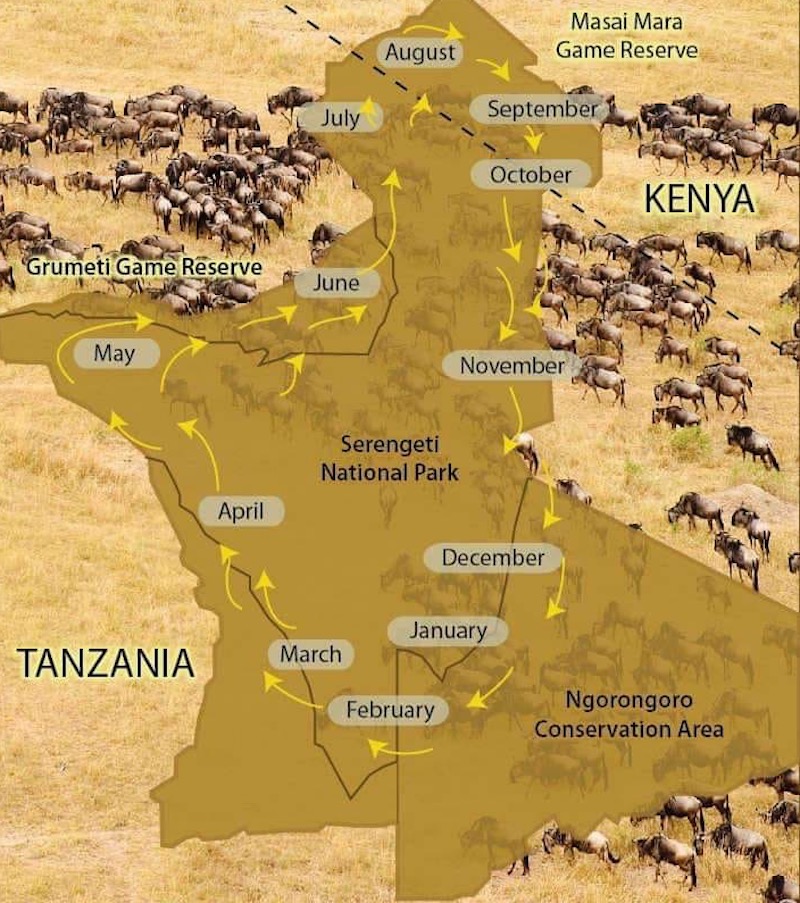The wildebeest migration is arguably the most fascinating mass movement of wildlife in Africa.
This spectacle brings thousands of safari travelers to Masai Mara game reserve and the
Serengeti national park. This herbivores migration routes are determined by the rains. They
have well mastered the rain patterns and this has now become an annual movement with a
similar pattern. In travel essence, this is the best season to plan your safari to Kenya and
Tanzania. There is not only a mass movement of wildebeest but also large families of wildcats in
hot pursuit. For the predators it’s a time of plentiful harvest and this will be reflected by their
sizes and grown tummies. For the herbivores, the short sprouting grass after rains is what
drives them. This kind of grass is very rich in nutrients and therefore very beneficial to the
growing herds.
The migration consists of wildebeests which are the majority in numbers in addition to Zebras
and antelopes in the groups. This herbivores peacefully co-exist since they each eat different
parts of the same vegetation. There is no competition for food. The herds experience a lot of
obstacles during the migration including predators and large rivers which they have to get
across. The wildebeest migration is probably the greatest animal show on the planet. From the
calve dropping in February, movement and crossing the Grumeti river is Serengeti and the
Mara river in Kenya’s Masai Mara in the peak of July and August. This is one journey that can be
followed and documented all year around, simply because the herds are always on the move.
Wildebeest migration Monthly Trail.
January – Ndutu Plains & Maswa (Southern Serengeti)
This is dry month is east Africa. The herds are usually in the north and headed for Ndutu plains
in southern Serengeti. At this time the wildest are heavily pregnant and are awaiting the first
signs of rain so that they can make their move. Their destination depends on where the rains
fall because at this time, they need very fresh grass to sustain the young ones. The animals are
in their thousands and therefore move in large groups at a time.
February – Ndutu Plains (Ngorongoro conservation Area)
This is the perfect month for a wildebeest calving safari in Tanzania. Each year within a span of
3 weeks, the herds drop the calves in the Ndutu plains. Thousands of calves are born in
synchrony and thus have a better chance of survival from the predators. The calves are able to
stand in minutes and even able to run in 5 minutes. In fact this species of antelope is the most
developed at birth. It’s a battle of life with predator which include the big cats in Serengeti in
addition to hyenas, Jackals and wild dogs The migratory herds have no time to relax an always
on the move following the rains. Playing is one way that the calves use to strengthen their legs.
They need it for the journey that lies ahead of them. It’s a bittersweet animal action arena, as
natural as it can get. Accommodation in Ndutu is quite limited, plan and book early.
March – Ndutu Plains – Seronera (Central Serengeti)
March is a rainy season in Tanzania. The young calves do not move long distances as they are
still young and not strong enough. However the wildlife have a large dispersal area and can
move from one place to another in this month. Majority of the numbers are based in the north
of the plains which is close to the Serengeti giving them more food and nutrition.
The predators have a lot to feed on since the calves are easy prey. If you have a love for cats of
photographic safari in Tanzania, then this is the best time to go in pursuit of the wild cats.
April & May – Mbalageti – Grumeti (Western corridor)
East Africa experiences the heavy rainy season in this months. Serengeti is very wet in the
month of May. If you have a sense of adventure and humor, then pack your bags and let’s
meet in the Serengeti plains. The heavy cotton solid becomes soggy and slippery. Driving can be
a real thrill. The migrating calves have gained momentum too and are no headed to the
western side in the woodlands. The action between predator and prey is high. The kopjes and
woodland are perfect hiding spots for the prey. They are also good sighting spots too.
June – Grumeti – Kogatende (Northern Serengeti)
This is the month of mass movement. The herbivores are widely dispersed in the plains. Far and
wide, they roam in the plains for greener pastures as the predators lie in wait or give chase in
the plains. This also the time the herds are rut. It is an extensive amorous affair. It’s still the
time that they make their safari across the Grumeti River. However the dry season is fast
approaching and unfortunately the water levels are low. The groups are scattered and cross
differently. The crossing is not as epic as the Maasai Mara crossing. The migration camps are
most recommended at this time as they move with the herds.
July & August – Kogatende – Masai Mara (Kenya)
This is the peak of the Kenya Wildebeest migration safari. After crossing the Grumeti River the
herds congregate in large numbers in northern Serengeti getting into the Maasai Mara game
reserve in Kenya. In their thousand, the hooved mammals roam the plains as the predator
follow in pursuit. The grass is greener here and in plenty. From a vantage point you get a view
of the thousands of herds as they move in long files.
The main challenge is crossing the Mara River which at the time is flowing in might. The
Gigantic Nile crocodiles wait in the water and for those that make it across, the big cats lay
waiting in ambush. It is a show of might and the unfolding balance of nature unfolding. This is
a perfect time to experience the migration safari in Kenya. However we advise that you book
early to get lodges and camps that are close to crossing points. We recommend the camps and
lodges that are within the park. You will not have to drive long distances to the Masai Mara
River. This is doing of nature and the wildebeest cross the river at will. Therefore game drives
can be long as you wait at vantage points for them to initiate a move. When it begins, you are
assured of an indescribable thrill. This is the icing on the cake for any safari to Kenya at this
time.
September – Masai Mara – Bologanje area (Eastern Serengeti)
In this time, the wildebeest are in the thousands scattered across the plains. It is a hot and dry
month. The last of the migrating herds have already made it into the masai Mara plains. Form
above, the plains look all dotted with the millions of back animals in their thousand. The grass is
getting depleted by and they move across the plains to wherever pasture is favorable.
Sometimes they also get in to nearby conservancies and adjoining plains.
October.
It’s now time to head back into Serengeti as they short rains have started in this region. En
route the wildebeest will encounter patches of green pasture in the areas that were first
depleted since it a season of short rains in Kenya. Depending on this rains, the herbivores seen
to make a lot of movements between the southern Masai Mara and eastern Serengeti. They
only hurdle this time is crossing back over the Mara river. At this time, the herds cross back in
smaller groups. Other herds may stay back and become residents here.
November – Bologanje – Namiri Plains (Central Serengeti)
The wildebeest migration herds have crossed all odds and are back into Serengeti. It is one of
the most treacherous journeys that they have to make for survival. With the females already
pregnant and a long way along, the herds congregate in central Serengeti. The Seronera area is
a perfect choice for your stay at this time if you are on a migration Safari in Tanzania.
Wildebeest are the most predictable animals and rest assured where there are rains you will
find them. Seronera is wet at this time and the wildebeest get a lot of salts and nutrients from
this area.
December – Seronera & Moru Kopjes (Central Serengeti – Southern Serengeti)
The hoofed mammals at this time have started eyeing the southern n Serengeti side for the
cycle to start all over again. Considering that their movement is entirely dependable on the
rains, the herds may stay here or start moving into the Ndutu plains in readiness for the calving
season. At this time, we advise that you engage your Tanzania safari expert for advice of where
best to see them. They are predictable yes, but the rains determine it. You will be better placed
if you are at the right area in the right time. The wildebeest migration is one of the most epic wildlife encounters that you can have in your
safari to Africa. In addition to the migration, there are other safari destinations in Kenya and
Tanzania that make your stay worthwhile. Depending on your safari interest, we can be able to
customize a safari itinerary that will best suites you. We are experts in this field, We take you to
the wildlife spectacles that others just dream about.

